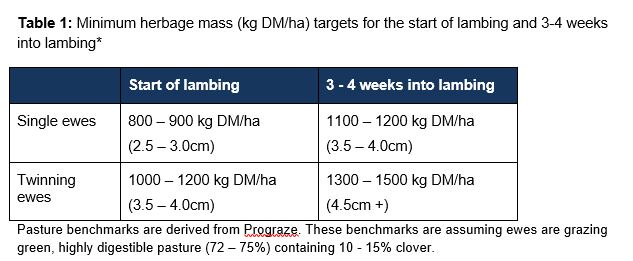Tips for managing lambing ewes
August 2019
Matthew Lieshcke, Senior Agriculture Advisor
Check pasture availability
Producing milk is energy intensive, so lactating ewes have increased nutritional requirements. Nutritional Management of lactating ewes involves assessing pasture available to determine if requirements will be met.
Pasture benchmarks for single and twin bearing ewes are shown in Table 1. Due to drought conditions these benchmarks are a bit lower than what is normally recommended, but will ensure that ewes and lambs are still able to perform to a good level. If you are not able to assess pasture on a kilograms of dry matter basis (kg DM/ha), use pasture height in Table 1 as a guide.
It’s important to note that the pasture benchmarks are for the start of lambing. To maintain adequate livestock performance the stocking rate (ewes/ha) needs to be set so that pasture growth is able to keep pace with livestock consumption.
Improve lactation
If the above pasture benchmarks are not met, it may be necessary to supplement ewes during lambing. While this is far from an ideal situation, providing adequate nutrition during the first 4 weeks of lactation is important to drive milk production. This is particularly important for twin bearing ewes and ewes that lamb down in relatively light condition (e.g. Fat Score 2.5 or less) as they have less fat reserves to draw upon.
The amount of supplement required will be a function of pasture conditions, ewe condition, stocking rate, number of lambs at foot and level of production that you are targeting. Cereal grains that are high in energy are likely to deliver the best ‘bang for buck’, but protein also becomes important where pasture is very short.
The Winter Feeding Guide – Sheep has been developed to help you fine-tune your feeding program. There is a lot of time and cost associated in feeding stock, so it’s important to get some precision around what you are feeding (energy and protein) and how much you are feeding out. It’s far too costly to leave to guess work. One way of calibrating your feed cart is to put a bag or tarp under your feed cart and weigh how much grain is released in a given amount of time (e.g. 15 seconds).
Make sure there is enough room at the bar
Feeding ewes via a self feeder is generally preferred over trail feeding as there is less disturbance of the mob, thereby reducing the risk of mismothering. However, if you are using a self feeder it is critical that the number of feeders is matched to the size of the mob. The general rule of thumb is no more than 200 ewes per self feeder. By reducing the number of ewes per feeder you reduce the risk of shy feeders and smothering issues at the feeder. Some recent research is indicating that reducing mob size can also have a positive impact on lamb survival, especially for twinning mobs.
If you don’t have enough self feeders for all your ewes, allocate them on a priority basis. For example, if you’ve scanned, use the self feeders for your twining mobs and trail feed the singles. If you haven’t scanned, you might allocate self feeders to maiden ewes or those ewes in poorer condition.
If you are trail feeding, daily feeding in the early afternoon (where possible) is the preferred approach to reduce the risk of mismothering.
